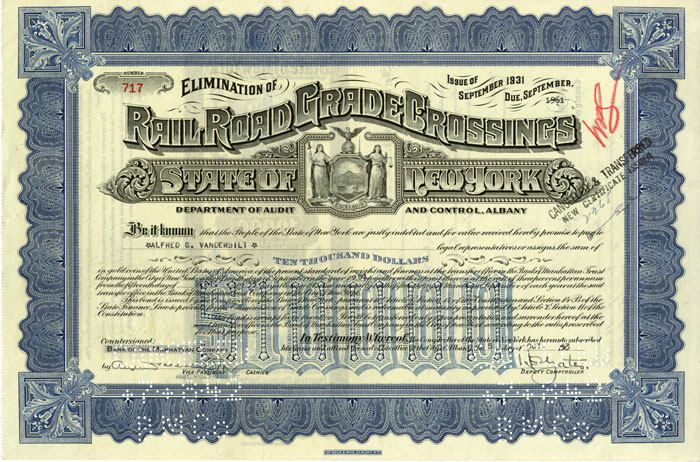Alfred G. Vanderbilt, Jr signed Elimination of Railroad Grade Crossings - 1930's dated Autograph Railway Bond
Inv# AG1849 Bond
$1,000 3% State of New York Bond issued to and signed on transfer by Alfred G. Vanderbilt. Printed by Quayle & Son, New York.

Alfred Gwynne Vanderbilt, Jr. (September 22, 1912 – November 12, 1999) was a member of the prominent Vanderbilt family, a son of the first Alfred Gwynne Vanderbilt, who died a hero in the sinking of the RMS Lusitania. His mother, Margaret Emerson (daughter of the Bromo-Seltzer inventor Isaac E Emerson), was one of America's wealthiest women and most sought-after hostesses, operating at least seven large estates around the country. His grandfather, Cornelius Vanderbilt II, had been one of America's most revered businessman; his great-grandfather, William Henry Vanderbilt had been the richest man in the world. "Commodore" Cornelius Vanderbilt started the family fortune in shipping and railroads as the founder of the New York Central Railroad and builder of Grand Central Terminal in New York.
Vanderbilt was one of the original members of the Westchester Racing Association and a driving force behind thoroughbred racing in America for most of the 20th century. His mother took him to his first race, the Preakness Stakes, in 1922. He often said, "After that, I was hooked." On his 21st birthday, his mother gave him Sagamore Farm, her racing operation in Glyndon, Maryland, which had been left to her by her father, Captain Isaac Emerson. Emerson was the inventor of Bromo-Seltzer and founder of the Emerson Drug Company, which later became Warner-Lambert.
Vanderbilt personally oversaw the breeding and training of his stable. He was elected to The Jockey Club as the youngest member in its history in 1935 and eventually campaigned four national champions: Discovery, Next Move, Bed O' Roses and Native Dancer. During the late 1930s and early 1940s, he owned and ran Pimlico Racetrack outside Baltimore and arranged the famous match race between Seabiscuit and War Admiral in 1938. He was President of Belmont Park and Pimlico at the same time before joining the Navy. During the Second World War, he captained a PT boat in the South Pacific and was awarded the Silver Star for bravery under fire. He then returned to racing, bringing his greatest champion, Native Dancer, to the track in 1952. Native Dancer won all 9 starts as a 2-year-old and was named Horse of the Year. He won every start as a three-year-old too, except the Kentucky Derby, which he lost by a head to Cain Hoy Stable's Dark Star. However, Native Dancer was named 3-year-old Male Champion and was Horse of the Year again in his 4th year. All told, he won 21 of 22 starts, with the single second-place finish in the 1953 Kentucky Derby his only career loss. Many consider the Grey Ghost of Sagamore to have been the first Thoroughbred television star, and TV Guide ranked him as a top icon of the era.
Vanderbilt continued racing throughout his life and served as Chairman of the Board of the New York Racing Association from 1971 to 1975. The New York Turf Writers voted him "The Man Who Did The Most for Racing" a record four times, posthumously renaming the award in his honor.
In the early 1950s, he was a regular panelist on the NBC game show Who Said That? along with H. V. Kaltenborn, Boris Karloff, and American actress Dagmar.
A bond is a document of title for a loan. Bonds are issued, not only by businesses, but also by national, state or city governments, or other public bodies, or sometimes by individuals. Bonds are a loan to the company or other body. They are normally repayable within a stated period of time. Bonds earn interest at a fixed rate, which must usually be paid by the undertaking regardless of its financial results. A bondholder is a creditor of the undertaking.










Ebay ID: labarre_galleries